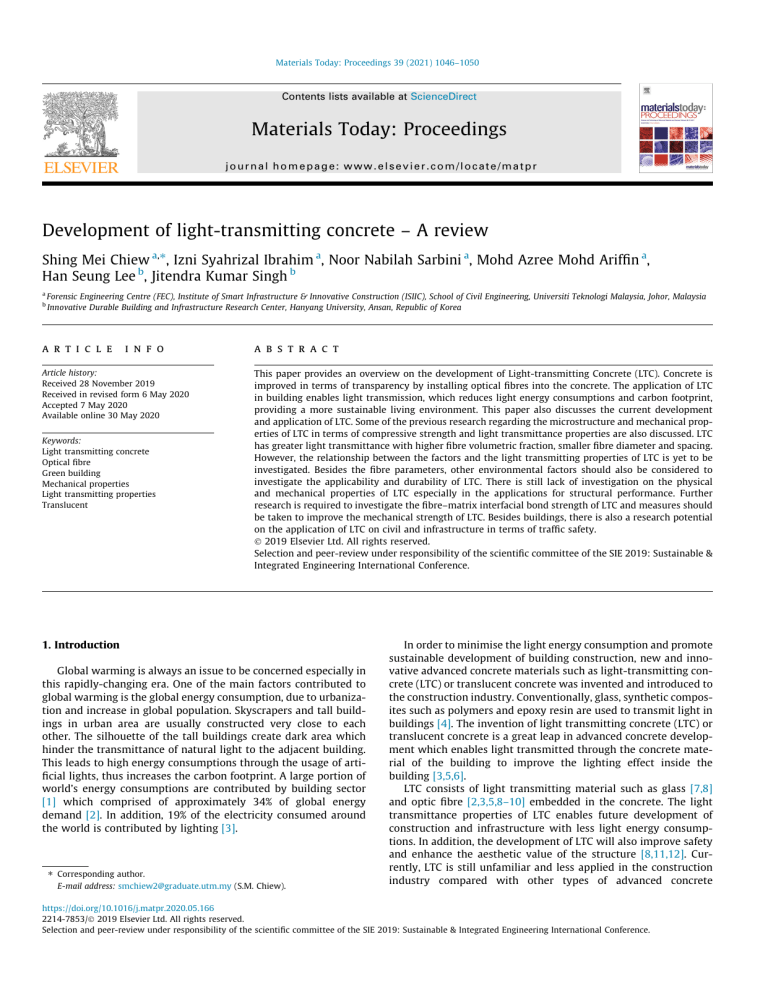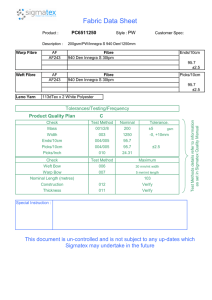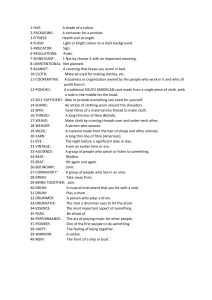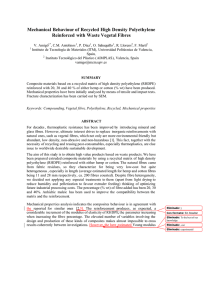
Materials Today: Proceedings 39 (2021) 1046–1050 Contents lists available at ScienceDirect Materials Today: Proceedings journal homepage: www.elsevier.com/locate/matpr Development of light-transmitting concrete – A review Shing Mei Chiew a,⇑, Izni Syahrizal Ibrahim a, Noor Nabilah Sarbini a, Mohd Azree Mohd Ariffin a, Han Seung Lee b, Jitendra Kumar Singh b a b Forensic Engineering Centre (FEC), Institute of Smart Infrastructure & Innovative Construction (ISIIC), School of Civil Engineering, Universiti Teknologi Malaysia, Johor, Malaysia Innovative Durable Building and Infrastructure Research Center, Hanyang University, Ansan, Republic of Korea a r t i c l e i n f o Article history: Received 28 November 2019 Received in revised form 6 May 2020 Accepted 7 May 2020 Available online 30 May 2020 Keywords: Light transmitting concrete Optical fibre Green building Mechanical properties Light transmitting properties Translucent a b s t r a c t This paper provides an overview on the development of Light-transmitting Concrete (LTC). Concrete is improved in terms of transparency by installing optical fibres into the concrete. The application of LTC in building enables light transmission, which reduces light energy consumptions and carbon footprint, providing a more sustainable living environment. This paper also discusses the current development and application of LTC. Some of the previous research regarding the microstructure and mechanical properties of LTC in terms of compressive strength and light transmittance properties are also discussed. LTC has greater light transmittance with higher fibre volumetric fraction, smaller fibre diameter and spacing. However, the relationship between the factors and the light transmitting properties of LTC is yet to be investigated. Besides the fibre parameters, other environmental factors should also be considered to investigate the applicability and durability of LTC. There is still lack of investigation on the physical and mechanical properties of LTC especially in the applications for structural performance. Further research is required to investigate the fibre–matrix interfacial bond strength of LTC and measures should be taken to improve the mechanical strength of LTC. Besides buildings, there is also a research potential on the application of LTC on civil and infrastructure in terms of traffic safety. Ó 2019 Elsevier Ltd. All rights reserved. Selection and peer-review under responsibility of the scientific committee of the SIE 2019: Sustainable & Integrated Engineering International Conference. 1. Introduction Global warming is always an issue to be concerned especially in this rapidly-changing era. One of the main factors contributed to global warming is the global energy consumption, due to urbanization and increase in global population. Skyscrapers and tall buildings in urban area are usually constructed very close to each other. The silhouette of the tall buildings create dark area which hinder the transmittance of natural light to the adjacent building. This leads to high energy consumptions through the usage of artificial lights, thus increases the carbon footprint. A large portion of world’s energy consumptions are contributed by building sector [1] which comprised of approximately 34% of global energy demand [2]. In addition, 19% of the electricity consumed around the world is contributed by lighting [3]. ⇑ Corresponding author. E-mail address: [email protected] (S.M. Chiew). In order to minimise the light energy consumption and promote sustainable development of building construction, new and innovative advanced concrete materials such as light-transmitting concrete (LTC) or translucent concrete was invented and introduced to the construction industry. Conventionally, glass, synthetic composites such as polymers and epoxy resin are used to transmit light in buildings [4]. The invention of light transmitting concrete (LTC) or translucent concrete is a great leap in advanced concrete development which enables light transmitted through the concrete material of the building to improve the lighting effect inside the building [3,5,6]. LTC consists of light transmitting material such as glass [7,8] and optic fibre [2,3,5,8–10] embedded in the concrete. The light transmittance properties of LTC enables future development of construction and infrastructure with less light energy consumptions. In addition, the development of LTC will also improve safety and enhance the aesthetic value of the structure [8,11,12]. Currently, LTC is still unfamiliar and less applied in the construction industry compared with other types of advanced concrete https://doi.org/10.1016/j.matpr.2020.05.166 2214-7853/Ó 2019 Elsevier Ltd. All rights reserved. Selection and peer-review under responsibility of the scientific committee of the SIE 2019: Sustainable & Integrated Engineering International Conference. S.M. Chiew et al. / Materials Today: Proceedings 39 (2021) 1046–1050 materials. This is because of the lack of comprehensive and convincing data and information regarding the mechanical properties, light transmittance properties and the durability of LTC. The scientific research on composition, material preparation and characteristics of LTC are scarce and scattered despite of some commercial reports [2,4,13]. This paper is aimed to discuss and review existing references and database, and draw out the gaps of the research. 2. General background The idea of light transmitting concrete was first introduced by a Hungarian Architect named Aron Losonczi in 2001 [10–12]. The architect used 4% optical fibre to invent the light transmitting concrete, named LiTraCon (Light Transmitting Concrete) [12]. LiTraCon was invented primarily for the architectural and interior design applications, illuminated the building by either natural light or artificial light [14]. Fig. 1 shows the product of LiTraCon [8]. There are several types of LTC where concretes are embedded by various translucent materials such as plastic, glass or optical fibre [15]. Nevertheless, due to higher light transmittance tendency, most of these LTC applied in the construction industry was made from the combination of concrete and optical fibre. Hence, this paper will only focus on the review of LTC incorporated with optical fibre. Optical fibre comprised of core, cladding and coating. Light is transmitted through the core whereas, cladding is the outer optical material which refractive index is smaller than the core to detent the total internal reflection in the core [16]. The most common optical fibres used in producing LTC are glass fibre and plastic fibre (or Polymethylmethacrylate fibre). Table 1 shows the classification of LTC with glass fibre and plastic fibre [17] based on the materials used, strength and weaknesses. In addition, both types of optical fibres are efficient in light transmittance, however, plastic fibre is more resilient to damage and requires lower cost compared with glass fibre [18]. Light is transmitted through optical fibre by total internal reflection. When the incident ray passes through a transparent 1047 object, refraction occurs. However, if the angle of the incident ray exceeds the critical angle, light will be reflected instead of refraction. Total internal reflection in optical fibre can be classified into three categories, which are multimode graded-index fibre, multimode step-index fibre and single-mode step-index fibre [10] (refer to Fig. 2). Single-mode optical fibre can only transmit light in one mode, whereas multimode optical fibre can transmit multiple light modes simultaneously [10]. Table 2 shows the advantages and disadvantages of LiTracon. Despite the high cost which becomes the main drawback of utilization of LTC in construction industry, LTC is actually an innovative construction material which promotes green building and indirectly reduces the carbon footprint especially in urban area where high dependency of artificial light is required. Furthermore, LTC is resistant to high UV, frost and de-icing salt [8]. Hence, it is durable under harsh weather and is highly recommended in cold countries. Since the main purpose of LTC is to transmit light and reduce energy consumptions, there is a diverse range of applications which LTC can be implemented, such as floors, facades, pavements, cladding, staircase, partition walls and others [3]. For structural performance, there are several buildings which had been successfully constructed with the application of LTC, as shown in Fig. 3. In addition, LTC has potential to be implemented in infrastructure despite buildings to reduce the light energy consumptions especially during night time. Garcia et al. [19] conducted experiments to investigate the potential of LTC to be used in constructing the pergolas of road tunnels. The experiments concluded that using LTC as pergolas can direct sunlight to the road tunnel while maintaining the homogeneity of light in the tunnel [19]. Saleem et al. [20] proposed translucent concrete-based smart lane separator by using optical fibre, which can transmit light and act as lane marking to the road user, in addition to convey useful real-time road conditions to the drivers, such as road accident and traffic density. Besides that, speed bumps and dark sidewalks can also be illuminated by LTC to increase visibility at night [8]. However, these applications of LTC on traffic safety require further investigation and development. 3. Production of LTC Fig. 1. LiTraCon [8]. Table 1 Classification of LTC with glass fibre and plastic fibre [17]. Type Materials Strength Weakness LTC with glass optical fibre LTC with plastic optical fibre Silica with small amount of dopants Transmit light effectively over large distances Heavy weight Expensive Fibre cladding is made of silicone or Teflon Flexible Inexpensive Easy to install Withstand greater stresses Light weight Only practical in short run Fibre core is made of Polymethylmethacrylate or polystyrene LTC is normally produced by mixing cement, sand and optical fibre [17]. Some researchers [12,21] used coarse aggregates with size not more than 10 mm for structural purpose. The volumetric fraction of optical fibre normally embedded in LTC is 2.5–5% for effective light transmission [15,17]. It is reported that LTC with optical fibre more than 4% will reduce its compressive strength drastically and affect its structural performance [12]. There are several methods for the installation of optical fibre into the casting moulds. Altlomate et al. [3] cut the fibres into specific length and inserted the fibres through holes in the formwork which prefabricated specifically in the research work, as shown in Fig. 4. The optical fibre used by Roye et al. [21] undergone textile process to form a layered fabric before installing into the formwork for casting. The concrete block was then demoulding and cut to the specific size after concrete hardened. Li et al. [22] introduced a preparation method where the fibres were embedded into the concrete matrix by means of parallel arrangement patterns without textile manufacturing process. 4. Compressive strength of LTC Compressive strength is one of the important properties which should be determined for a construction material to identify its capacity of compressive resistance. Most of the compressive strength tests conducted on LTC by previous research [4,9,22] were 1048 S.M. Chiew et al. / Materials Today: Proceedings 39 (2021) 1046–1050 Fig. 2. Total internal reflection of optical fibre [10]. Table 2 Advantages and disadvantages of LiTraCon [15]. Advantages Compressive strength of 50 MPa and bending strength of 7 MPa Different dimensional blocks can be manufactured Aesthetic value for building due to its light transmitting properties A potential to be used as construction material. Reduction of light energy consumption Disadvantages The inclusion of optical fibre will lower the strength of concrete compared to plain concrete Expensive. Around 800 euros per meter square of thickness. Only available for prefabrication or precast concrete. Casting in-situ is not allowed focused on the application in light transmitting in building. During compressive strength test, the compressive load is applied perpendicular to the direction of the optical fibre arrangement. Li et al. [22] reported that the compressive strength of the light transmitting cement mortar (LTCM) with volumetric fraction of 4% optical fibre is 81% of that of plain cement mortar. Through Scanning Electron Microscopic (SEM) analysis, they further concluded that the reduction of compressive strength was contributed by the existence of gaps between the fibre and mortar interface [22]. Henriques et al. [4] also reported the similar result that the compressive strength of concrete decreased due to the inclusion of optical fibre. Through observation under SEM analysis and capillary water absorption test, they found that voids existed between the fibre–matrix interface due to the weak bond contributed by extremely smooth and slippery surface of the optical fibre [4]. Sawant et al. [10] reported that with the increment of optical fibre volumetric fraction, the compressive strength of LTC reduced. On the other hand, Altlomate et al. [3] and Kumar et al. [12] reported the adverse results where they suggested that the compressive strength of LTC increased with the increment of the optical fibre volumetric fraction. However, the fibre volumetric fraction in the study from Atlomate et al. [3] is only limited to less than 2%, which the percentage is lower than the normal volumetric fraction Fig. 4. Installation of optical fibre into the wood formwork [3]. used in LTC (2.5–5%), as mentioned in the previous section. When the fibre volumetric fraction increases and greater than 2%, the smaller fibre spacing results in smaller interconnecting distances for microcracks propagation especially under compressive load. This weakens the bond within the concrete matrix interface and results in lower compressive strength. Hence, further research is required to overcome this phenomena, which maintain the intensity of light transmittance without compromising the compressive strength of LTC. Bashbash et al. [9] reported that the compressive strength of LTC increased with the increment of the optical fibre diameter. This is because fibre with bigger diameter is stiffer and able to aid in withstanding the compressive load compared to fibre with smaller diameter. Momin et al. [16] who studied the light transmittance of concrete using optical fibres and glass rods reported that the compressive strength with glass rod is higher than the specimen with optical fibre. This is because the stiffness of glass rod is higher than the optical fibre. Fig. 3. Buildings with applications of LTC: (a) Al-Aziz Mosque in Abu Dhabi, (b) Italian pavilion at Shanghai World Expo, China, and (c) Radhous building in Erfurt, Germany [3,14]. S.M. Chiew et al. / Materials Today: Proceedings 39 (2021) 1046–1050 Overall, most of the research revealed that the inclusion of optical fibre will decrease the concrete compressive strength. In addition, there are also few researchers after going through SEM analysis discovered that the decrease in concrete compressive strength [3,4,6,22] was due to the weaker fibre–matrix interfacial bond. Among the existing research and previous references, only Li et al. [6] took action to improve the fibre–matrix interfacial bond by treating the fibre with silane coupling agent. In order to enhance the mechanical strength of LTC, the research on fibre–matrix interfacial bond and appropriate measures to improve the bond strength should be further investigated. 5. Factors affecting light transmitting properties The main purpose of the invention of LTC is to transmit light through the concrete. Hence, light transmittance test is necessary to determine the capability of LTC to transmit light. The apparatus used are usually consisted of light source and light meter [4,12] (or light-dependent resistor [3]). Previous research [2–4,10–12] suggested that the light transmittance of LTC increased with the increment of optical fibre volumetric fraction. High occurrence of light interference due to bigger amount of optical fibre results in higher light transmittance of LTC. Tuaum et al. [2] reported that the light transmittance of LTC decreased with the increment of fibre diameter. This is because more fibre with smaller diameter can be embedded within the same size of LTC specimen compared with optical fibre with bigger diameter [2]. On the other hand, Momin et al. [16] stated that the increment of fibre spacing will decrease both the concrete compressive strength and the light transmittance. This is because the superposition of light wave with constructive interference reduced with the increment of fibre spacing. The distance between the light source and LTC specimen also affects the performance of LTC on light transmittance. Tuaum et al. [2] stated that the increment of distance between light source and LTC will decrease the light transmittance of LTC. Most of the research discussed previously only limited on the investigations regarding the factors affecting the light transmittance and compressive strength of LTC. Nevertheless, the relationship among these factors and their effects on LTC is yet to be discovered. Further investigation is required on the relationship between fibre volumetric fraction, fibre diameter, fibre spacing and the light transmittance properties of LTC. Besides the parameters on fibres, other environmental factors such as visibility, light intensity, angle of light incidence, and fibre degradation should be considered for further investigation to confirm its applicability and durability before it can be safely used in the construction industry. 6. Conclusion Light transmitting concrete (LTC) is an innovative construction material which transmits light through the concrete and improves the lighting effect inside the building. LTC can reduce the light energy consumptions and carbon footprint produced, which promotes green building construction especially in urban area. There are a few countries have implemented LTC in their buildings which promote aesthetic view and eventually drive the growth of tourism. The scientific research on LTC is still limited since it is a brand new material introduced in construction industry recently. Most of the research conducted on LTC is more focused on its utilization in architecture and buildings rather than infrastructure. For the mechanical properties of LTC, approaches should be taken and investigated to minimise the problems arose from fibre-matrix 1049 interfacial bond strength. Furthermore, there is still lack of scientific investigation on the relationship between fibre volumetric fraction, fibre diameter, fibre spacing and the light transmittance of LTC. Apart from that, other environmental parameters should be considered to investigate the applicability and durability of LTC so that the implementation of LTC can be more expansive and comprehensive in the construction industry. CRediT authorship contribution statement Shing Mei Chiew: Conceptualization, Writing - original draft, Writing - review & editing, Resources, Visualization. Izni Syahrizal Ibrahim: Conceptualization, Resources, Writing - review & editing, Supervision. Noor Nabilah Sarbini: Supervision. Mohd Azree Mohd Ariffin: Supervision. Han Seung Lee: Funding acquisition. Jitendra Kumar Singh: Funding acquisition. Declaration of Competing Interest The authors declare that they have no known competing financial interests or personal relationships that could have appeared to influence the work reported in this paper. Acknowledgements The authors would like to express their gratitude for the financial support by Universiti Teknologi Malaysia and Hanyang University Korea of this project by Research Grant No. 4B358. References [1] K. Amasyali, N.M. El-Gohary, A review of data-driven building energy consumption prediction studies, Renew. Sustain. Energy Rev. 81 (2018) 1192–1205. [2] A. Tuaum, S.M. Shitote, W.O. Oyawa, Experimental evaluation on light transmittance performance of translucent concrete, Int. J. Appl. Eng. Res. 13 (2018) 1209–1218. [3] A. Altlomate, F. Alatshan, F. Mashiri, M. Jadan, Experimental study of lighttransmitting concrete, Int. J. Sustainable Build. Technol. Urban Dev. 7 (2016) 133–139. [4] T.D.S. Henriques, D.C. Dal Molin, Â.B Masuero, Study of the influence of sorted polymeric optical fibers (POFs) in samples of a light-transmitting cementbased material (LTCM), 2018, Constr. Build. Mater. p.161 p. 305–315. [5] P. Shanmugavadivu, V. Scinduja, T. Sarathivelan, C. Shudesamithronn, An experimental study on light transmitting concrete, Int. J. Res. Eng. Technol 3 (2014) 160–163. [6] Y. Li, J. Li, H. Guo, Preparation and study of light transmitting properties of sulfoaluminate cement-based materials, Mater. Des. 83 (2015) 185–192. [7] S.L. Pagliolico, V.R.L. Verso, A. Torta, M. Giraud, F. Canonico, L. Ligi, A preliminary study on light transmittance properties of translucent concrete panels with coarse waste glass inclusions, Energy Procedia 78 (2015) 1811– 1816. [8] S. Juan, Z. Zhi, Some progress on smart transparent concrete, Pac. Sci. Rev. 15 (2013) 51–55. [9] B.F. Bashbash, R.M. Hajrus, D.F. Wafi, M. Alqedra, Basics of light transmitting concrete, Basics Light Transmitting Concr. 2 (2013) 76–83. [10] A. Sawant, R. Jugdar, S. Sawant, Light transmitting concrete by using optical fiber, Int. J. Inventive Eng. Sci 3 (2014) 23–28. [11] S. Paul, A. Dutta, Translucent concrete, Int. J. Sci. Res. Publ. 3 (2013) 1–10. [12] A. Kumar, R. Ahlawat, Experimental Study on Light Transmitting Concrete, 2017, Int. J. Innov. Sci. Eng. Technol. 4 p. 201–210. [13] Y. Li, Z.Y. Xu, Z.W. Gu, Z.Z. Bao, Research on the light transmitting cement mortar, Adv. Mater. Res. (2012) 397–401. [14] A. Yadav, S. Shekhar, A. Anand, A. Badal, B. Zaman, An investigating study on a new innovative material: transparent concrete, Int. J. Eng. Res. Adv. Dev. 4 (2018) 64–72. [15] M. Zielińska, A. Ciesielski, Analysis of transparent concrete as an innovative material used in civil engineering, in: IOP Conference Series: Materials Science and Engineering, 2017, p. 022071. [16] A. Momin, R. Kadiranaikar, V. Jagirdar, A. Inamdar, Study on light transmittance of concrete using optical fibers and glass rods, in: International Conference on Advances in Engineering & Technology, 2014, pp. 67–72. [17] B. Han, L. Zhang, J. Ou, Light-transmitting concrete, in: Smart and Multifunctional Concrete Toward Sustainable Infrastructures, ed: Springer, 2017, p. 273–283. 1050 S.M. Chiew et al. / Materials Today: Proceedings 39 (2021) 1046–1050 [18] M. Bhushan, D. Johnson, M.A.B. Pasha, M.K. Prasanthi, Optical fibres in the modeling of translucent concrete blocks, Int. J. Eng. Res. Appl. (IJERA) 3 (2013) 013–017. [19] A. Peña-García, L.M. Gil-Martín, O. Rabaza, Application of translucent concrete for lighting purposes in civil infrastructures and its optical characterization, Key Eng. Mater. 663 (2016) 148–156. [20] M. Saleem, M.M. Elshami, M. Najjar, Development, Testing, and Implementation Strategy of a Translucent Concrete-Based Smart Lane Separator for Increased Traffic Safety, 2016, J. Constr. Eng. Manage., 143 p. 04016129. [21] A. Roye, M. Barlé, T. Gries, S. Janetzko, Faser-und textilbasierte Lichtleitung in Betonbauteilen-Lichtleitender Beton, Beton-und Stahlbetonbau 104 (2009) 121–126. [22] Y. Li, J. Li, Y. Wan, Z. Xu, Experimental study of light transmitting cementbased material (LTCM), Constr. Build. Mater. 96 (2015) 319–325.







